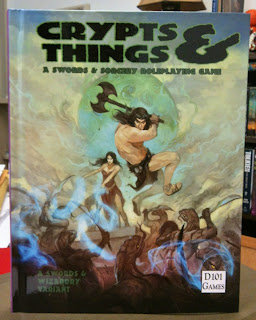Since I've added comics to Vargold's blogging remit, I thought it might be nice to write a post about G0dland artist Tom Scioli's gonzo web-comic American Barbarian. Set in a post-apocalyptic American akin to that of Jack Kirby's Kamandi and the cartoon Thundarr the Barbarian, American Barbarian pits its Kirbyeseque hero, the red-white-and-blue-haired warrior Rick Yoosamon, against the villainous giant Two-Tank Omen. (He's a pharaoh with tanks for feet.) You can read the entire book on Scioli's website (linked above) or buy a hardcover copy from AdHouseBooks.
In this post, I want to focus on a gag of Scioli's that not only demonstrates the series' sense of humor but also shows the sort of artistic effect that comics can pull off effortlessly. Early on in the series, the forces of Two-Tank Omen attack and kill Rick's father and brothers. When Rick discovers his family's bodies, he fights through his grief to a sense of outrage and a desire for vengeance, a desire he makes permanent by marking it on his flesh:
The immediate reveal of what Rick carves on his fingertips is an unfortunate Photoshop job on what appears to be Scioli's own hands. Much better is the drawn reveal as Rick attempts to get close to Two-Tank Omen by pretending to want to join the villains' forces. The word balloons on the page contain the lies Rick tells Two-Tank Omen; the character POV in the last panel reveals the truth of what Rick feels in his heart:
Triple exclamation-points aside, this panel is not the gag's pay-off, however. That comes latter as Rick directly takes the fight to Two-Tank Omen in pitched battle. He makes short work of the villain's minions, but misses his chance to kill his family's murderer. Rick finds himself once again staring at his fingers—not with determination but with recrimination:
In the top tier of the page, Scioli replicates the POV of the earlier panel where Rick swears his "allegiance" to Two-Tank Omen. But he pulls back to a more distant position, isolating Rick and emphasizing the diminishment that comes with failure. We're not sharing Rick's POV here, but critically look at him. The bottom tier reverses the "camera" angle and zooms in, giving us a shot of Rick's expression as he considers his fingers. The grim punchline follows on the very next page. The implicit question is "Revenge!!!?" The answer is:
That top panel is one of my favorite in all comics. Scioli uses the mirror-image effect in Rick's pupil to turn heroic will into impotent failure, "revenge" into "never." He underlines the point by zooming in even further and adding red blood vessels to connect to the red scars on Rick's fingertips. It's a brilliant gag, and I can't see it being pulled off anywhere but comics. You could possibly do it in film, but it would appear contrived whereas here it appears wholly natural. American Barbarian is thus on one hand Kirby-pastiche but on another Tom Scioli's own artistic statement. I highly recommend it.
(BTW, if these pages don't convince you to read the book, how about this one?
"Robosaurs? I'm fucked!" is essentially more or less the cri-de-coeur of every Old School player character ever.)

















